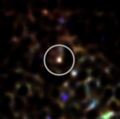 COCONUTS-2b with unWISE. The planet in the center of the image stands out due to its red color. The host star is not pictured here. | |
| Discovery | |
|---|---|
| Discovered by | Zhoujian Zhang Michael Liu Zach Claytor William Best Trent Dupuy Robert Siverd [1] |
| Discovery date | August 2011 (as a free-floating brown dwarf) [2] |
| Direct imaging | |
| Designations | |
| WISEPA J075108.79-763449.6 [2] | |
| Orbital characteristics | |
| 7,506+5,205 −2,060 AU [4] (1.123×1012km) | |
| 1.1+1.3 −0.4×106 [4] years | |
| Star | L 34-26 |
| Physical characteristics | |
| 1.122+0.005 −0.004 RJ [5] | |
| Mass | 7.5±0.4 MJ [5] |
| log(g) = 4.17±0.02 cgs [5] | |
| Temperature | 493±9 K [5] |
Spectral type | T9.5±0.5 [6] |
COCONUTS-2 b is a gas giant exoplanet that orbits the M-type star L 34-26. With a mass of 8 Jupiters, [6] it takes over one million years to complete one orbit around the star orbiting 7,506 AU away from it. [1]
Contents
The planet was discovered in 2011 and was initially identified as a T9 free-floating brown dwarf WISEPA J075108.79−763449.6. [2] During the COol Companions ON Ultrawide orbiTS (COCONUTS) survey, its association with L 34-26 was announced in 2021. [7] At a distance of 35.5 light-years (10.9 parsecs ), COCONUTS-2b was the closest directly imaged exoplanet to Earth [8] until Epsilon Indi Ab was imaged in 2024.






